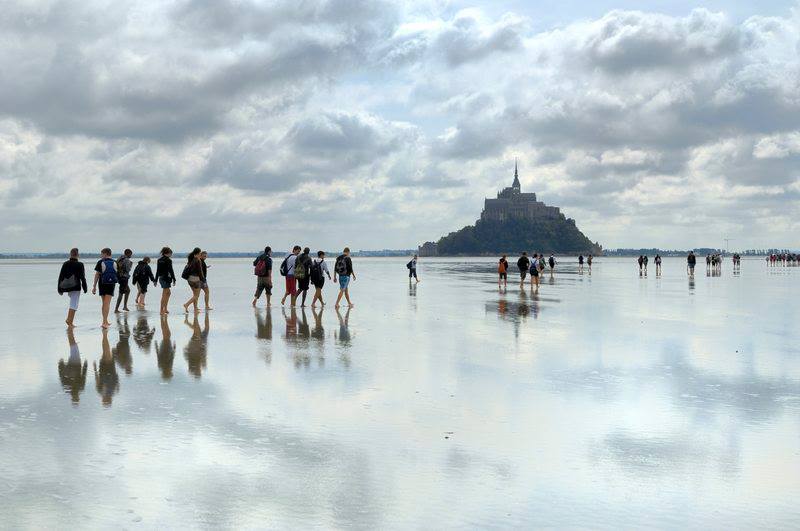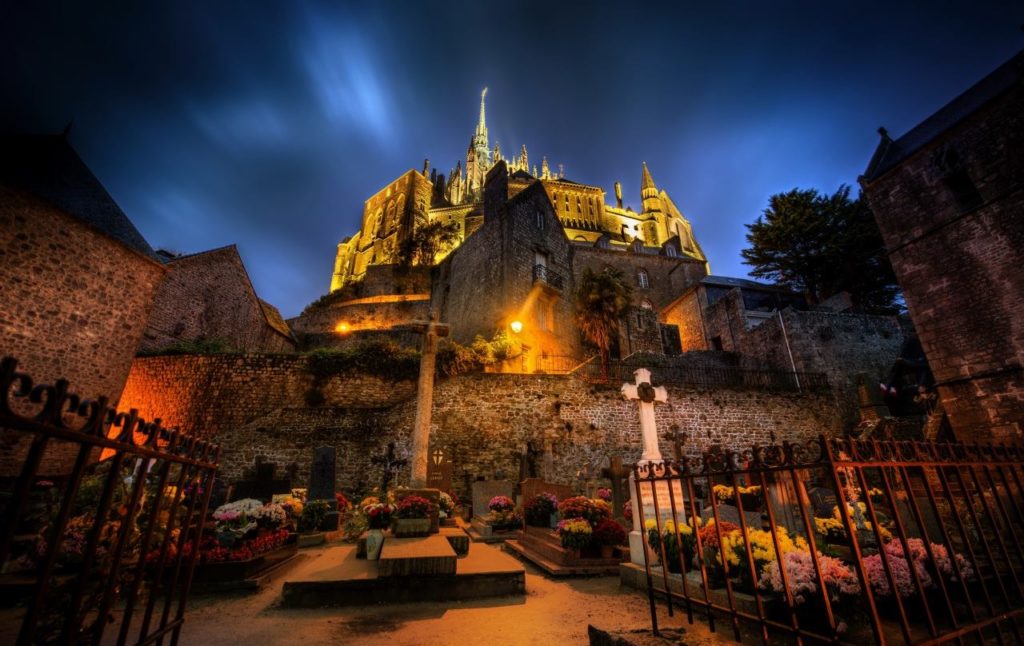Interesting Facts About Mont Saint Michel
Let’s now discover one of France’s religious sites that is steeped in history, located 150 miles northwest of Paris. Mont Saint Michel is an important place of worship; however, it is also a fortified site that shares a history with Normandy and its past wars with England.
Here Are Some Interesting Facts About Mont Saint Michel
Mont Saint Michel, the Fortified Abbey
Mont Saint-Michel is a monastery erected at the top of a small rocky island that overlooks the sea. It is located right between Brittany’s and Normandy’s borders. The statue of Archangel Saint Michael towers 170 meters (560ft.) above the English Channel. Mont Saint Michel was an island until a road was built at the end of the 19th century. It was separated from the shore by 1 mile of sand at low tide, or by water at high tide.
The range in tides is one of the greatest in Europe; it can be 46 feet between high and low watermarks. The bay around Mont Saint-Michel is completely flat, and the rising tide is said to sometimes equal the speed of a running horse. In the early 8th century, according to catholic literature, Archangel St. Michael directed the bishop of Avranches, Saint Aubert, to build the monastery.
From the year 1000 on, and for 6 straight centuries hereafter, the Dukes of Normandy and the pilgrims funded the construction of new structures despite the challenge of building on an island only accessible by foot. During the French Revolution, the walled abbey became a prison for political rivals. Mont Saint Michel was designated an official French National Heritage Site in 1872 and is restored on a yearly basis by the French Government, much to the delight of its visitors.

The First Bank Loans
During the 11th century, the monks living at Mont Saint Michel had to come up with new ways of earning financial returns on their assets. For the first time in history, a religious community did not have to work for a living, thanks to the generous gifts of the pilgrims. Their capital was the land they either bought or were given by princes and kings, and their income came from 3 different sources:
- They worked the land with the help of servants.
- Rented some plots for 10% of the harvest, which was much more than the monks needed for themselves, so they sold or traded the surplus.
- They even became bankers and granted loans in exchange for land that they could then exploit for the duration of the loan! Income obtained that way was essentially interest, and thus the first bank loans were made in the Middle-Ages!
For the first time in history, a religious community did not need to work for a living. The pilgrims, who were filled with wonder at the Month St. Michel and its fortified monastery, supported them with their donations!
>>Things To Do In Mont Saint Michel
Mont Saint Michel: The Impregnable Fortress!
A direct attack against Mont Saint Michel was all but impossible because of its solid fortifications and strategic geographic position. In September 1591, the Count of Montgomery plotted to take over the fortress. He took a Norman soldier prisoner and offered him money to hang a rope from the abbey walls: this would allow English soldiers to climb up and enter the monastery. The Norman soldier agreed but later felt guilty and confessed the plot to the monks. They dropped the rope as planned, and the English soldiers were killed one by one as they reached the top of the walls. Throughout the following centuries, no one was ever able to invade Mont Saint Michel. This was proof to the pilgrims that this site was indeed protected by Archangel Saint Michael.
The Mysterious Prisoner
During the French Revolution, Mont Saint Michel became a prison. In 1815, a man named Mathurin Bruneau came back from America, claiming to be Louis XVI’s son and demanded his right to the throne! Mont Saint Michel His uncle Louis XVIII wasn’t about to give up his crown. Officially, Louis XVII had died in 1795, but nobody was quite sure about this. Mathurin tried to prove his real identity by writing to his sister, the Duchess of Angouleme. She replied with a list of private questions that only her brother would have been able to answer. Unfortunately for him, he never did receive this letter (it remains today in the French National Archives). He spent five years in the Mont Saint Michel prison and died in 1825. So no one will ever know the truth!

Is Mont Saint Michel on Brittany or Normandy?
Not so simple!
Brittany and Normandy are separated by the River Couesnon, which has several times changed its bed during past centuries, leaving Mont Saint Michel sometimes in Brittany, sometimes in Normandy. Nowadays, Mont Saint Michel is officially in Normandy, and Normans are very proud of it. There is a saying: “The River Couesnon in its lunacy, has gone and left Mont St. Michel in Normandy”! But who knows for how much longer…
Looking for a Partner for Camembert?
In terms of combining food and beverage, two rules prevail: flavor similarity and flavor contrast. Another rule French people like to follow is pairing a dish and a drink from one particular region. For instance, a ripe Camembert from Normandy may be better appreciated—contrary to any preconceived notions—with a hard cider! Normandy produces more than one third of all French cider and is the 1996 birthplace of AOC (Appelation d’Origine Contrôlée) cider, the “Cidre du Pays d’Auge”. There are three types of cider in France:
- Sweet and lightly alcoholic (1.5 to 3%): “Cidre doux”
- Less sweet and a bit more alcoholic (4.5 to 5%): “Cidre brut”
- Dry, bitter and cloudier (unfiltered, 6% alcohol): “Cidre Tradition”
If you have a sweet tooth, you’d probably choose the Cidre doux with a ripe Camembert, but true Normans would only consider drinking the Cidre Tradition with their famous cheese. If you are not quite that adventurous, why not try the Cidre brut with traditional crepes from Brittany, another French region that produces cider.

